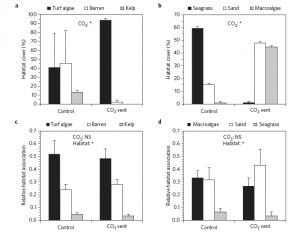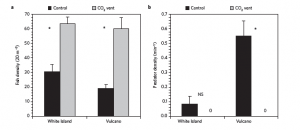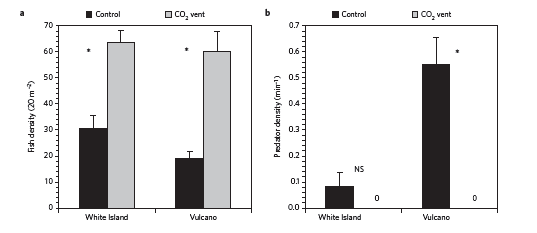Ocean acidification alters fish populations indirectly through habitat modification
By Shannon Moorhead, SRC Intern
In recent years, it has become apparent that increased CO2 emissions have farther reaching consequences than simply raising the temperature of Earth’s atmosphere. A significant amount of CO2 is absorbed by the ocean, which raises its acidity through chemical reactions with water molecules. This process, termed ocean acidification, has a large number of potentially detrimental effects on biodiversity, interactions between species, and individual species fitness. Elevated CO2 levels encumber the ability of certain invertebrates, such as corals and snails, to build calcium carbonate skeletons and can drive habitat shifts that degrade ecosystems. Laboratory experiments have also shown that prolonged exposure to CO2 negatively affects the ability of fish to perform predator-avoidance behaviors.
Nagelkerken et al 2015 explores the effects of ocean acidification with in situ study, meaning the experiment was done in the natural habitat of the subject species. A field study allowed for the researchers to account for the indirect effects of changes in habitat on fish behavior and abundance, necessary to more accurately predict species responses to ocean acidification, as well as their potential consequences for ecosystems. The authors observed habitat coverage, fish habitat association, fish escape response performance, and fish and predator population density at 2 separate locations: White Island, New Zealand and Vulcano Island, Italy. Both sites are characterized by vents that naturally produce CO2, maintaining the acidity of the surrounding water at a much higher than average level, levels that the rest of the oceans may reach by the end of the century.

a,b, Habitat cover at White Island (a) and Vulcano Island (b). c,d, Fish density in each habitat at White Island (c) and Vulcano Island (d)
At both locations, habitat coverage changed significantly between the control sites (far enough away from the vents to not be affected by the elevated CO2) and the sites near the vents. Increased acidity caused ecosystem phase shifts; complex ecosystems mottled with vegetation, algae, patches of rock or sand give way to simpler communities dominated by either algae or sand near the vents. The fish species observed, the common triplefin and Bucchich’s goby, both associated primarily with algae and sand or rock bottom areas. Increased biomass of preferred habitat, along with higher levels of prey abundance in these habitats, most likely contribute to the significant difference in fish density observed between the vent and control sites. Fish density near the vents was greater than double density measured at control sites. This may have also been a result in part of the lack of predatory fish observed near the CO2 vents.

a, fish escape speed at White Island (top panel) and Vulcano Island (bottom panel). b, jump distance (distance fish moved while escaping) at White Island (top panel) and Vulcano Island (bottom panel). c, startle distance at White Island (top panel) and Vulcano Island (bottom panel)
Though effects of elevated CO2 actually improved fish abundance, it still had negative effects on the behavior of the fish species. Fish at vent sites escaped threats more slowly than fish at control sites and usually waited until the threat was closer to begin moving away, indicating CO2 exposure lessened the ability of the fish to avoid predation. One exception to this, in the algae dominated habitats at the Vulcano Island site, there was little difference between the startle distance (distance from the threat to the fish when the fish starts its escape) of fish living at the control sites and fish living near the vents. Fish may begin their escape response later in this habitat because they feel more relaxed knowing they have easy access to shelter.

a, fish density at White Island and Vulcano Island. b, predator density at White Island and Vulcano Island
This study is the first example of the negative direct effects of ocean acidification on fish behavior being counteracted by indirect effects that actually increase fish abundance and survival. Contrasting laboratory-based predictions that less productive and simpler ecosystems would harm fish populations, this paper demonstrates the need for more in situ studies on the effects of elevated CO2 levels. Indirect effects, such as changes in predator and prey abundance and habitat phase-shifts, must be considered when attempting to accurately predict the consequences of climate change.
Nagelkerken I, Russel BD, Gillanders BM, Connell SD (2016) Ocean acidification alters fish populations through habitat modification. Nature Climate Change 6: 89-93




Trackbacks & Pingbacks
[…] Shannon Moorhead, Shark Research (University of Miami), 14 January 2016. Article. […]
Leave a Reply
Want to join the discussion?Feel free to contribute!